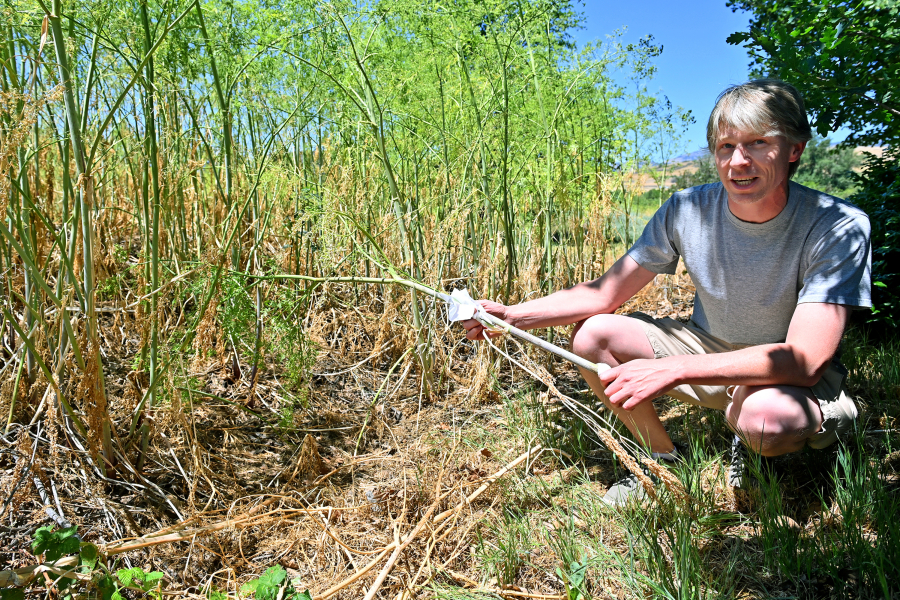MEDFORD, Ore. — Spring rain falling on the Almeda Fire scar has spurred a bumper crop of innocuous-looking but highly poisonous hemlock flowers.
“With the Almeda Fire, we just had a fairly large ecological reset,” said Greg Stabach, program manager for the natural resources staff at Rogue Valley Council of Governments.
Stabach said he has worked in the Rogue Valley for 20 years and has always dealt with hemlock, but conditions this year created a unique expansion of the invasive species. In areas that are disturbed, like construction zones, recreation areas or the fire scar, invasive species move in quickly, Stabach said, referring to hemlock as “an early colonizer.”
The plant that poisoned Socrates is native to the Mediterranean and thrives in Southern Oregon’s climate. Hemlock is especially well established in the riparian corridor — the belt of ecology connected to Bear Creek.
“Near any unmanaged stream in Southern Oregon, there’s probably going to be hemlock,” said Clint Nichols, forest and riparian resource conservationist for Jackson Soil and Water Conservation District.
A small amount can be deadly to humans and animals. KEZI 9 news reported that a family cat in Veneta was paralyzed and had to be euthanized after taking a nap in a patch of hemlock that had grown in the family’s yard without their knowledge. The family identified it after one of them brushed against it and developed a rash.
A member of the carrot family, hemlock sports frilly leaves and flowers that resemble the wildflower Queen Anne’s lace, but hemlock is larger. Mature plants are 6 to 8 feet tall with hollow, bamboolike stems.
“The telltale signs of any poison hemlock is going to be reddish purplish splotches — almost like bruises — up and down the stem,” Nichols said.
There are two varieties of hemlock, Nichols explained, water hemlock and poison hemlock.
“The irony is that water hemlock is lethal; poison hemlock is toxic,” Nichols said. “That’s the joy of common names.”
Water hemlock is relatively rare in Southern Oregon, Nichols said, and he advises people to simply avoid anything that looks like hemlock.
Funding, sense of urgency
Stabach said various organizations have been coming together to try to beat back invasive weeds such as hemlock for a long time, but until the Almeda Fire, there wasn’t enough funding or human labor to do more than attack small, separate areas. Funding and a sense of urgency after the fire resulted in a concerted effort, but the work was still too slow to keep invasive species out.
Agencies had to first address safety concerns such as dead trees and possible soil contaminants. Then crews surveyed the damage and began replacing native plants. By then, invasive species already had colonized the area.
Carl Strauss, who runs a small business doing weed removal and habitat restoration, said he works on the hemlock in winter, when the plants have begun to sprout and are small. To avoid touching them, he uses small amounts of carefully chosen herbicide.
“Even in the areas where I did a lot of work, new hemlock came up,” Strauss said of this year.
Each plant produces hundreds of seeds, Strauss said. Bear Creek carries them downstream, and the seeds can sit in soil for over five years before germinating. Usually, work of this kind is done only on public land, but hemlock does not discriminate between public or private land as it grows.
Strauss advises landowners to use a shovel and remove the roots, if the plants are few and someone is uncomfortable with herbicides. For those using herbicides, Strauss said less is plenty and anyone near waterways needs EPA aquatic-approved products.
Nichols said to never burn or compost the plant. Anyone attempting to remove it with a lawnmower or cutting it should use a mask as slicing into hemlock aerosolizes the toxin.
“It’s going to take a lot of years of concerted effort,” Strauss said of removing the noxious weed from the Rogue Valley.



